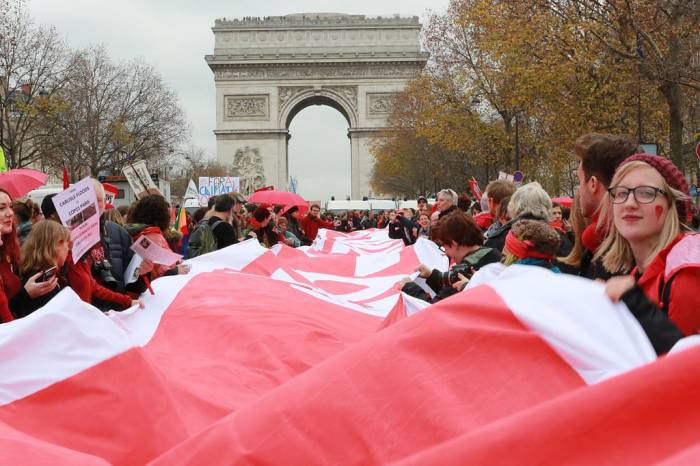For me, the Paris negotiations of 2015 actually took place on Sixth Avenue in New York a year earlier.
That is to say, my experience of the Paris accords is somewhat unusual, in that I never even made it inside the negotiating hall itself. Truth be told, the agreement was not that important to me; instead, the mere fact of the negotiations was the crucial thing, because it gave civil society the chance to bring climate change front and center.
For me, the journey began at Copenhagen (2009), or maybe at Kyoto (1997). Because I’d written the first book for a general audience about climate change, I was fascinated by those Japanese talks. They seemed to be the moment at which the world would decide to take its gravest crisis seriously—but, as it turned out, that didn’t really happen. The U.S. punted, and indeed most of the countries of the world just kept spewing greenhouse gases throughout the decade that followed. Then we all adjourned to the Danish capital—“Hopenhagen,” they were calling it. Surely here, with the damage from climate change now easily visible, we would find action. But no—nothing. A profound failure.
But a failure that was useful in one way. It helped some of us realize that without a real movement forcing politicians, we would never get action. They would forever pontificate and forever avoid anything even close to real action. And so we got busy organizing. At 350.org we put together something like 20,000 rallies in every country on earth except North Korea. We went to jail by the thousands to stop new fossil fuel projects. We organized campus after church after pension fund to divest from fossil fuels. We helped build a movement where none had been before. And so, by 2014, we were able to put that movement to use.
With Paris clearly on the horizon, we called people into the streets. Never before had we attempted a true mass rally—truth be told we were always afraid that not enough people would show up, that it would fail. But now we were at least hopeful that the tide had begun to turn. And so—acting in concert with thousands of different organizations—we issued the call for people to come to the streets of New York while the UN was in session, to send a message that the time had come. We hoped very badly that 100,000 people might turn up; that would have been by far the largest climate demonstration of all time.

When the morning dawned—muggy and cloudy, but not thank God raining—I remember arriving on the streets of the upper West Side. It was early, but people seemed to be gathering. There were politicians on hand, and we had to explain that they would not be leading the parade: that honor went to young people and to indigenous people, on the theory that they had the most at stake and were in any event the de facto leaders of our fight. As we held press briefings and the like, people kept arriving—soon the side streets along Central Park West were so crowded that we began to worry. How would anyone march?
Our worries were in one sense correct—it took hours past the set start time for most people to begin walking, simply because the streets were so clogged. But people seemed thrilled by the inconvenience—they understood perfectly that it meant, finally, the climate movement had turned out in force. And what a parade! Churches and synagogues, following labor unions, following scientists in white lab coats, some of them wheeling blackboards with equations. Since New York is a city of immigrants, it made sense that blocs marched representing countries facing flood or drought. Even Ban Ki-moon, Secretary-General of the UN, marched—which is atypical behavior for the strenuously non-partisan holder of that post.
Building momentum for Paris was the goal, and it definitely helped. A few weeks later Barack Obama told the UN, “when people march we have to listen.” It’s not that we changed his mind—it’s that we gave him, and others, some room to operate. And—not unimportantly—we made it impossible for them to come home from Paris empty-handed. Copenhagen was a bust because the Obamas of the world had nothing to fear; they could return in failure and not pay a price. But there was enough of a movement by the time of Paris that taking a pass would have come with a heavy political price.
So what did we do in Paris, instead of going to the negotiating sessions? Well, we kept building the movement. More marches and demonstrations (though some were constrained by the attack on the Bataclan). Remarkable concerts organized by Pathways to Paris. Small sit-down rallies on the grounds of the talks themselves. Why? Because we knew—even before Trump—that the Paris accords were not an end in themselves. They were obviously not going to solve the problem, even if they began the process of setting up some kind of framework. Since they were a series of voluntary pledges, people in every country would need to hold their leaders accountable. Since they failed to achieve their stated goal of holding temperature increases to 1.5 or even 2 degrees, we’d need to push to strengthen them. And all of that meant that our most useful work was building the movement stronger and more resolute.
When news of the final agreement came, we were in the streets of Paris, in a big rally led by indigenous people from around the world. We were happy for the news from the negotiations, but not as overjoyed as the delegates and diplomats who were hugging and high-fiving. We knew it was another day—an important day, but not a decisive one—in the fight to save the climate. Winning that fight would mean building stronger movements, so the negotiators of the future would have more courage, or more fear.
To explore all the stories in the Profiles of Paris series, click here.